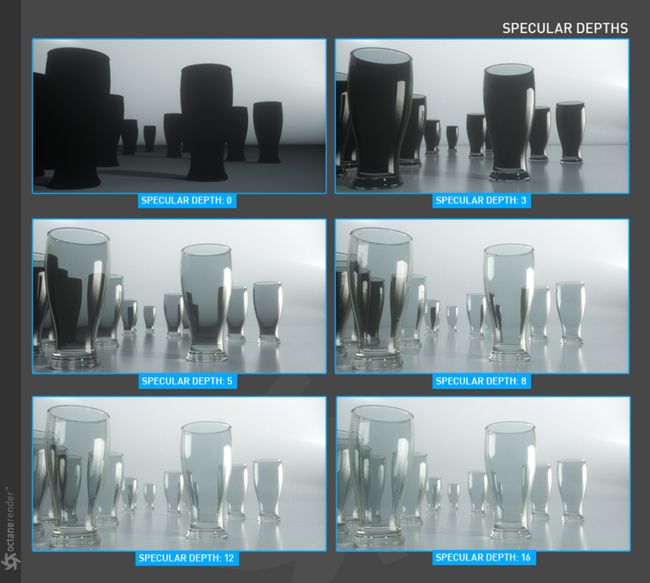==== 文章 引自 Octane Help ====
==== 翻译 Google translate ====
PATH TRACING
Now be ready to hunt for photons in the endless sea of Pathracing. Pathtracing is an advanced "unbiased" render method written for this purpose. With this method, you can obtain photorealistic images with physical certainty. Pathtracing may cause problems in some small light sources or you may not get full efficiency in the case of caustic reflections. In such cases you can use PMC Kernel (see PMC section).
现在准备好在无尽的Pathracing海中寻找光子。 Pathtracing是为此目的而编写的高级“无偏”渲染方法。 使用此方法,您可以获得具有物理确定性的逼真图像。 路径追踪可能会在某些 small Light sources 小型光源中引起问题,或者在caustic reflections腐蚀性反射的情况下可能无法获得完全的效率。 在这种情况下,您可以使用PMC内核(请参阅PMC部分)。
Unfortunately, every good thing has a drawback: this method increases render times. This is the price we will always pay when we try to infiltrate the reality through the computer.
不幸的是,每件好事都有一个缺点:这种方法会增加渲染时间。 当我们试图通过计算机渗透现实时,这是我们将永远要付出的代价。
As we have already mentioned, when using the common options of the kernels, there may be only kernel-specific options that you have chosen, or some of the previous ones may not be visible. When you choose Pathtracing, two new features "Caustic blur" and "GI Clamp" are activated. Below we will explain only these options. We have already explained all the other options in this section in Directlighting. You can look at those sections as needed.
正如我们已经提到的,当使用内核的公共选项时,可能只有您选择的特定于内核的选项,或者某些先前的选项可能不可见。 当您选择Pathtracing时,会激活两个新功能“Caustic blur”和“GI Clamp”。 下面我们将仅解释这些选项。 我们已在Directlighting中解释了本节中的所有其他选项。 您可以根据需要查看这些部分。
Max. Samples 最大采样 :
Sets the maximum number of samples per pixel before the rendering process stops. The higher the number of samples per pixel, the cleaner the render. There is no rule as to how many samples per pixel are required for a good render, it is subjective and may vary depending on the content and complexity of the scene being rendered. For example, since Directlighting is a fast kernel, 500-1000 samples for static images and animations will suffice. If you have more than one direct and indirect light source in your scene and you are also using mesh light, you can increase a few hundred samples. But we can not say the same thing for Pathtracing kernel mode, for instance. As we've just mentioned, there is no magic number for it.
设置渲染过程停止前每个像素的最大采样数。 每个像素的采样数越多,渲染越清晰。 没有关于良好渲染需要每像素多少采样的规则,它是主观的并且可以根据正被渲染的场景的内容和复杂性而变化。 例如,由于Directlighting是一个快速内核,静态图像和动画的500-1000个采样就足够了。 如果场景中有多个直接和间接光源,并且您还使用mesh light,则可以增加几百个采样。 但是,对于Pathtracing内核模式,我们不能这样说。 正如我们刚刚提到的,它没有固定的数字。
Diffuse Depth 漫射深度:
Gives the maximum number of diffuse reflections if GI Mode is set to Diffuse. 3-5 is enough for the most scenarios.
如果GI模式设置为“GI_DIFFUSE”,则给出最大漫反射数。 对于大多数场景来说,3-5就足够了。
Specular Depth :
Controls how many times a ray is refracted after hit the surface without losing its energy. A zero number means that the ray does not hit the surface and can not continue on the path (reflect or refract). if it is greater than zero, it continues on its way through the surface and refracts until it loses its energy. Higher numbers mean higher render times but more color bleeding and more details in transparent materials. Low numbers can introduce artifacts or turn some refractions into pure black. You can see different specular depth results from the picture below.
控制光线在击中表面后折射次数。零数字表示光线不会撞击表面,无法在路径上继续(反射或折射)。如果它大于零,它继续穿过表面并折射,直到它失去能量。 数字越大意味着渲染时间越长,但颜色渗透越多,透明材料的细节越多。 低数字可能会引入假象或将一些折射变成纯黑色。 您可以从下面的图片中看到不同的镜面深度结果。
Ray Epsilon :
The distance between the geometry and the light ray when calculating ray intersections for lighting and shadowing. Larger values push rays away from the geometry surface. Lower values are more accurate, but can cause artifacts on large or distant objects. Ray Epsilon is similar to Ray tracing bias in other rendering engines. Adjust Ray Epsilon to reduce artifacts in large scale scenes. Look at the picture below.
计算光线和阴影的光线交叉点时几何体与光线之间的距离。 较大的值会将光线推离几何表面。 较低的值更准确,但可能导致大型或远距离物体上的伪影。 Ray Epsilon类似于其他渲染引擎中的(Ray tracing)光线跟踪偏差。 调整Ray Epsilon以减少大型场景中的伪影。 看下面的图片。
从左往右:1.再大场景中过小的 Ray epsilon 会产生光斑;2.在超小模型场景中过大的数值会倒错误;3.适合的数值
Filter Size 过滤器尺寸 :
Sets the filter size in terms of pixels. This can improve aliasing artifacts in the render. However, if the filter is set too high, the image can become blurry.
以像素为单位设置过滤器大小。 这可以改善渲染中的锯齿伪像。 但是,如果滤镜设置得太高,图像可能会变得模糊。
CAUSTIC BLUR 焦散模糊 :
This feature is only active in Pathtracing and PMC Kernel. You can set the caustic reflections to look sharp or soft with this option. When you enter a low value, caustics will look sharp, but you can see the bright pixels called "fireflies" depending on the scene setup. When you enter high values, the caustics begin to appear blurry. This is one of the values you will definitely play in scene optimization.
此功能仅在Pathtracing和PMC内核中有效。 您可以使用此选项将焦散反射设置为锐利或柔和。 当您输入一个较低的值时,焦散会看起来很清晰,但您可以根据场景设置看到称为“fireflies”的明亮像素。 输入高值时,焦散开始变得模糊。 这是您在场景优化中肯定会发挥的价值之一。
Info: There are a few ways to reduce or eliminate Fireflies. In this Caustic matter, you can lower the GI Clamp value.
信息:有几种方法可以减少或消除萤火虫。 在此焦散物质中,您可以降低GI Clamp值。
GI CLAMP :
It clamps the contribution for each path to the specified value. By reducing the "GI clamp" value, you can reduce the amount of fireflies caused by sparse but very strongly contributing paths, i.e. it reduces noise by removing energy. "Caustic blur", on the other hand, reduces noise by blurring caustics, but conserves energy. Keep this number between 1-3.
它将每条路径的贡献限制为指定值。 通过降低“GI clamp”值,可以减少由稀疏但非常强的贡献路径引起的fireflies数量,即通过去除能量来减少噪声。 另一方面,“Caustic blur”通过模糊焦散来降低噪音,但节省能量。 将此数字保持在1-3之间。
